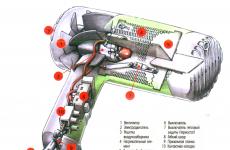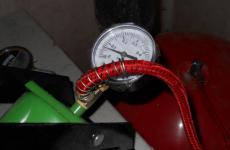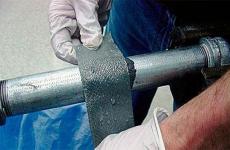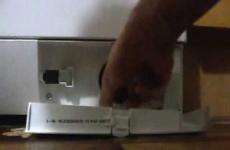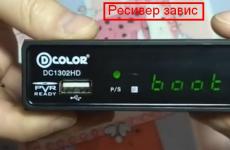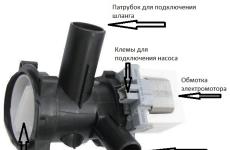Antenna for digital TV do it yourself
Previous analogue broadcasting has been completely discontinued since 2009. Changing the format to digital made it necessary to use an appropriate receiving device. Digital TV broadcasting is carried out in the UHF range, which is capable of accommodating many channels, having a compact and high signal quality. The increased transmission rate reduced equipment maintenance costs and made it more resistant to interference, although not all problems were completely resolved. In rural areas, signal reception is almost impossible, but in a big city it becomes more complicated due to the ability of the reinforced concrete structures of multi-storey buildings to screen the signal. For confident reception, it is quite possible to make an antenna for digital TV with your own hands, since its cost in the store is quite high.
How a digital antenna works
A digital signal differs from an analog one in that it does not transmit the wave itself, but information about it... That is, it consists of a continuous stream of "coordinates" of points of a specific sinusoid graph transmitted by conventional analog devices. This makes it possible to significantly reduce interference and improve the quality of signal transmission, since a failure in the transmission of information does not cause major problems and is calmly corrected when decoding the signal in the receiver. The rest of the transmission technology remains the same - electromagnetic oscillations are emitted from the transmitter into space, they are received by antennas in the line of sight, on the contours of which a small voltage appears, which is transmitted to the decoding device of the TV and turns into image and sound.
To receive decimeter waves, a small antenna size is required, which compares favorably with the previously used huge antennas that filled the roofs of houses. The dimensions of digital antennas are quite compact, so they can be freely placed in an apartment, on a balcony or in another place convenient for the owner and providing high-quality reception. A homemade antenna has a simple design and is quite accessible for manufacturing for people without special training, who have only basic knowledge.
Do-it-yourself loop antenna
A circular antenna for digital TV has the highest input impedanceA loop antenna is one of the simplest options. At the same time, the resistance to interference of such a device is very high, because the design combines a receiving antenna and an interference filter. The name "frame" refers to a specific configuration - it is a closed contour in the form of a round or rectangular frame. Made from copper wire. Alternatively, you can use a piece of antenna cable (RG6) stripped of vinyl.
Payment
To calculate the loop antenna, you only need to determine the length of the wire from which the frame is made... The calculation formula looks like this:
where LR is the length of the wire in the loop,
f - wave coefficient, which is the arithmetic mean between the values of the boundaries of the wave range. For example, if the broadcast is in the 568-720 MHz range, then f = 568 + 720/2 = 644.
You can find out the required ranges on the websites of the transmitting companies or from other sources - this information is freely distributed. The start and end frequencies are used for the calculation. If there is no final one, then the value of f is taken equal to the initial frequency.
Some experts give another version of the formula, according to which the side of the square frame is equal to 0.254 of the wavelength (or f). That is, the value obtained from the calculation according to the first formula must be increased by 1.5%. The difference is subtle, but in some cases it is important.
To make an antenna you will need:
- Pliers;
- Ruler;
- Soldering iron;
- A utility knife for stripping the insulation (if using an antenna cable).
Only the most basic tools are listed, depending on the skills and capabilities of the user, other devices that are more suitable for any purpose can be used.
Manufacturing instruction
Making a loop antenna is straightforward. You will need to do the following:
- Cut a piece of wire to the desired length. Experienced users are advised to first cut a piece a little longer than the calculation requires, so that it is possible to more accurately adjust the length when forming the antenna configuration.
- Shape the antenna into the desired shape. If a round loop is used, then it is necessary to make the circle as even as possible; for a square frame, the length of the sides should be exactly maintained.
- The ends of the frame are connected to the antenna wire from the TV: one end to the braid, the other to the central core. This task requires a soldering iron or a terminal block.
- It remains to install the device in the most suitable place for reception and adjust the position.
How to make an antenna Kharchenko
 You can make such an antenna with your own hands for receiving Wi-Fi
You can make such an antenna with your own hands for receiving Wi-Fi The design was proposed by K.P. Kharchenko in 1961. The main task is to receive television broadcasts, but practice has shown the high suitability and versatility of the invention. The external antenna of Kharchenko has the shape of an eight with an open middle. It consists of two squares, and the connection to the antenna wire is made at the midpoints. Thus, we have a closed loop of thick copper wire, which has a specific shape. The difference from the frame structure lies precisely in the more complex configuration, which allows to obtain stable and reliable signal reception, noise immunity and reliability. Its feature is broadband and the ability to receive both television and radio signals. It all depends on the location of the antenna - vertical receives a TV signal, horizontal - radio.
The figure eight is not the only possible option, you can increase the number of formed squares. Variants with the formation of circles, triangles, etc. are also known. The eight is used due to its ease of manufacture and adjustment, as well as the absence of interference.
Payment
Self-calculation of the Kharchenko antenna is not difficult, but includes the determination of many quantities. You will need to calculate the length of the side of the square, the size of the reflector (reflector), the total length of the figure eight from the top to the bottom point, the size of the gap between the reflector and the antenna, etc. Therefore, the simplest and most reliable solution will be to use an online calculator, of which there are many on the net. To get a more accurate result, you can try to count on several services and compare the data.
Required tools and materials
To assemble Kharchenko's antenna you will need:
- Thick copper wire with a cross section of about 4 mm 2;
- Aluminum plate for reflector (reflector). In its absence, a metal grid (mesh) can be used as a reflector;
- Pliers, hammer, screwdriver;
- Electric drill with a set of drills;
- Soldering iron, terminal block;
- Metal pipe or wooden long bars for the manufacture of a supporting structure (mast).
There are many design options for the manufacture of which you can use various accessories. If necessary, they are involved in the working order.
Manufacturing instruction
- According to the calculated data, an eight is made.
- The connection at the midpoint is soldered, the second point is tinned for the subsequent connection of the power supply.
- Holes are drilled in the reflector plate, into which the bosses for fastening the antenna are installed.
- It is fixed on the support bosses, a wire is soldered to the central points.
- The reflector plate is attached to the mast. For this, screws or clamps are used if it is made of a metal pipe.
- The mast with the antenna is installed in the designated place.
- It is connected to the TV, the optimal position is adjusted.
Other options
 A variant of the design of the Sotnikov antenna from three squares
A variant of the design of the Sotnikov antenna from three squares The options considered are not the only possible ones. There are many designs of antennas for receiving a television signal.
The following can be distinguished:
- Three-element wave channel. It is a rather complex structure of a horizontal strip, on which two transverse stripes and a T-shaped frame are installed. A variant of this design is a four-piece wave channel containing three crossbars and one T-shaped structure.
- Double square (Sotnikov antenna). Has a gain of 10-13 dB, it is represented by two square frames, located in parallel and connected by a crossbar. A variant of the design is a triple square, the authorship of which belongs to the same Sotnikov. The reinforcing ability is higher - in the region of 14-15 dB.
- Turkin's antenna. The amplification factor possessed by such a design is more than 15 dB. It consists of six rings of different diameters, fixed on a horizontal dielectric support rod. The device requires a rather careful calculation of the diameter of the rings and the distance between them.
Video: How to make an antenna for digital TV with your own hands
The transition of television to digital format took place in order to eliminate interference, increase transmission quality, more confident reception and compact equipment. The need to use your own antenna is due to the large amount of interference or distance from the repeater. In the absence of the possibility of acquiring a factory-made sample, which is quite expensive and not always commercially available, it is quite possible to make a home-made device, since there is no particular difficulty in this.

